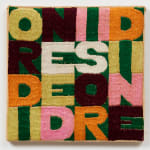
Alighiero Boetti Italian, 1940-1994
Ordine e Disordine, 1973
Embroidery
17.2 x 17.6 cm. (6 3/4 x 6 7/8 in.)
Copyright The Artist
Further images
Alighiero Boetti’s Ordine e Disordine (1973) is an embroidery from the artist’s first cycle of Arazzi, created at a pivotal moment in his practice. One of the few embroideries realised...
Alighiero Boetti’s Ordine e Disordine (1973) is an embroidery from the artist’s first cycle of Arazzi, created at a pivotal moment in his practice. One of the few embroideries realised in Afghanistan during the early 1970s – before production later moved to Peshawar, Pakistan, following the Soviet invasion of 1979 – it stands as a key expression of Boetti’s lifelong fascination with dualities, systems, and paradoxes.
The phrase “Ordine e Disordine” (Order and Disorder) had already occupied Boetti’s thinking since 1970, when he produced his first work under this title. That early experiment established the conceptual foundation for many of his later works: the relationship between structure and unpredictability. In 1971, he mounted the phrase within a grid using a stencil, spraying it in green paint on a wall. Written in Italian within a four-by-four arrangement, the words ran vertically down the grid without breaks, creating a dense visual field where sense and pattern intertwine. This same structure, later entrusted to Afghan craftswomen, became the basis for a series of embroidered variations – each realised in vivid, shifting colours that introduced chance into the order of design.
In Ordine e Disordine, the theme of order is evident in the geometric logic of the grid, the disciplined arrangement of letters, and the uniformity of font and form. The phrase always fits the square perfectly, encapsulating Boetti’s belief in the inherent beauty of systems. Yet this harmony is immediately unsettled by elements of disorder: the absence of spaces between letters disrupts readability, and the irregular chromatic choices made by the embroiderers transform each work into a unique composition. The result is a subtle visual and linguistic tension. What first appears ordered gradually reveals confusion and instability – an experience that both frustrates and fascinates the viewer.
Boetti’s Arazzi encode poetic phrases and idioms within embroidered grids, transforming language into image. Influenced by Persian and Arabic traditions of pattern and script, Boetti used these works to explore language as both a rational system and a field of uncertainty. His collaboration with Afghan women embroiderers – who interpreted his designs through their own aesthetic sensibilities – was central to this process. What began as a controlled framework became a site of shared creation, where order was continually inflected by the unpredictable hand of another. For Boetti, unity meant not homogeneity but the coexistence of differences.
Through Ordine e Disordine, Boetti distilled the essence of his artistic philosophy. The work embodies the coexistence of opposing forces – precision and ambiguity, control and chance, intellect and intuition. In its tension between legibility and confusion, the piece visualises Boetti’s conviction that true harmony arises only when order admits disorder, and when structure leaves room for surprise.
The phrase “Ordine e Disordine” (Order and Disorder) had already occupied Boetti’s thinking since 1970, when he produced his first work under this title. That early experiment established the conceptual foundation for many of his later works: the relationship between structure and unpredictability. In 1971, he mounted the phrase within a grid using a stencil, spraying it in green paint on a wall. Written in Italian within a four-by-four arrangement, the words ran vertically down the grid without breaks, creating a dense visual field where sense and pattern intertwine. This same structure, later entrusted to Afghan craftswomen, became the basis for a series of embroidered variations – each realised in vivid, shifting colours that introduced chance into the order of design.
In Ordine e Disordine, the theme of order is evident in the geometric logic of the grid, the disciplined arrangement of letters, and the uniformity of font and form. The phrase always fits the square perfectly, encapsulating Boetti’s belief in the inherent beauty of systems. Yet this harmony is immediately unsettled by elements of disorder: the absence of spaces between letters disrupts readability, and the irregular chromatic choices made by the embroiderers transform each work into a unique composition. The result is a subtle visual and linguistic tension. What first appears ordered gradually reveals confusion and instability – an experience that both frustrates and fascinates the viewer.
Boetti’s Arazzi encode poetic phrases and idioms within embroidered grids, transforming language into image. Influenced by Persian and Arabic traditions of pattern and script, Boetti used these works to explore language as both a rational system and a field of uncertainty. His collaboration with Afghan women embroiderers – who interpreted his designs through their own aesthetic sensibilities – was central to this process. What began as a controlled framework became a site of shared creation, where order was continually inflected by the unpredictable hand of another. For Boetti, unity meant not homogeneity but the coexistence of differences.
Through Ordine e Disordine, Boetti distilled the essence of his artistic philosophy. The work embodies the coexistence of opposing forces – precision and ambiguity, control and chance, intellect and intuition. In its tension between legibility and confusion, the piece visualises Boetti’s conviction that true harmony arises only when order admits disorder, and when structure leaves room for surprise.
